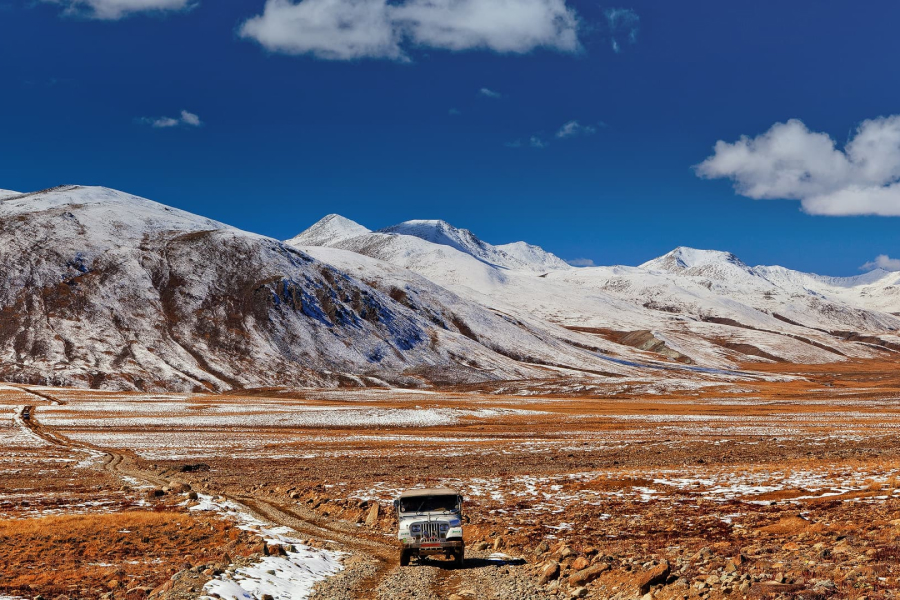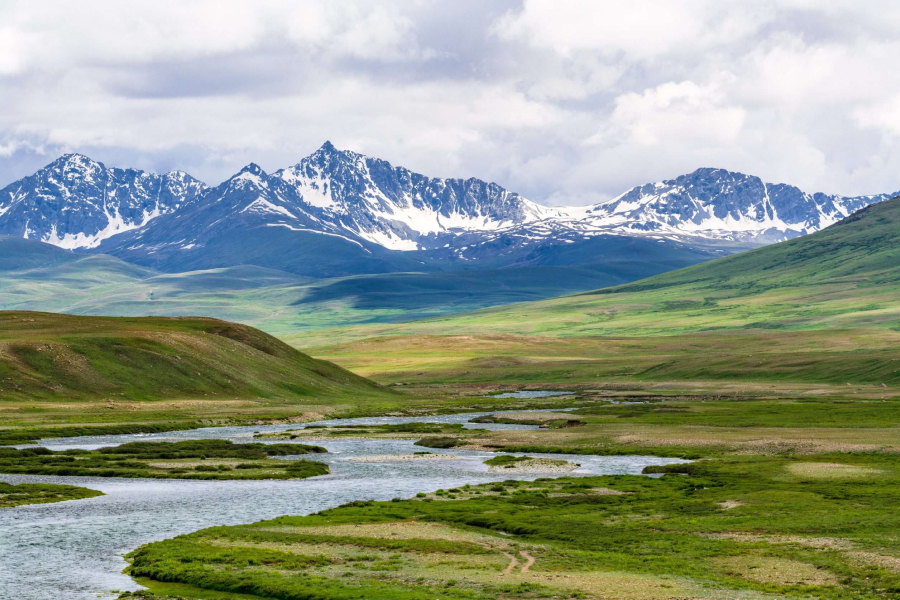The Allure of Deosai National Park:
1. Trekking: The park is a trekker’s paradise with various trails catering to different skill levels. The renowned Sheosar Lake trek or the Bara Pani trek offers stunning vistas of the surrounding landscapes.
2. Wildlife Watching: Deosai is known for its diverse wildlife. Visitors can spot the Himalayan brown bear, ibex, red foxes, and various bird species. Wildlife enthusiasts will find the park an absolute delight.
3. Camping: Camping under the starry skies of Deosai is an experience like no other. The vast plains and tranquil atmosphere make it an ideal spot for camping enthusiasts.
4. Photography: The picturesque scenery, particularly during sunrise and sunset, provides excellent opportunities for photography enthusiasts to capture the park’s beauty.
For an unforgettable adventure in Deosai National Park, explore the Deosai National Park Burji-La Trek.

Deosai’s Renowned Features:
1. Sheosar Lake: This stunning lake, situated at an elevation of 4,142 meters, is a prime attraction. Visitors can take in the serene beauty of the still waters surrounded by majestic mountains.
2. Floral Splendor: During the brief summer season, the park is adorned with a carpet of colourful flowers, presenting a picturesque landscape that’s truly mesmerizing.
3. Unique Ecosystem: Deosai is a high-altitude plateau that transforms into a snow-covered wonderland during winter. Its unique ecosystem is a sight to behold.
Best Time to Visit:
The park is accessible from late spring to early autumn, roughly from June to September. The weather is comparatively milder during these months, making it ideal for trekking, camping, and wildlife viewing. However, each season offers a unique perspective of Deosai’s beauty, whether the blooming flowers in summer or the snow-covered landscape in winter.
In conclusion, Tourist Activities in Deosai National Park offer a harmonious blend of adventure, serenity, and a chance to witness the unspoiled beauty of the natural world. Whether you seek thrilling escapades or a tranquil communion with nature, this park is a must-visit destination.

Navigating Through Deosai:
Accessibility:
The park is accessible from two main routes: Skardu, a prominent city in the region, and Astore. Visitors can reach Skardu via road or air and the journey to Deosai can be made via a scenic jeep ride.
Conservation Efforts:
Deosai National Park Burji-La Trek is not just a tourist destination; it’s a sanctuary for the region’s flora and fauna. Efforts in conservation and preservation ensure the protection of the park’s biodiversity, notably the critically endangered Himalayan brown bear. Understanding and supporting these Remarkable Deosai National Park Weather Phenomena conservation initiatives are crucial for the park’s longevity and preserving its unique ecosystem.
Planning Your Visit:
Accommodation Options:
While the park is a camping haven, there are accommodation options in nearby towns like Skardu or Astore. Lodges, guesthouses, and camping sites are available, catering to different preferences and budgets.
Essential Tips:
- Altitude Considerations: Desai’s high altitude may Require visitors to acclimatize appropriately to avoid altitude-related issues.
- Weather Precautions: Weather can be unpredictable, So packing appropriate clothing and gear for varying conditions is Essential.
- Local Guidelines: Adhering to park rules and regulations, especially regarding waste disposal and wildlife interaction, is vital to maintaining the park’s pristine environment.
Experiencing the Unseen:
Apart from the famous attractions, Deosai offers hidden gems waiting to be discovered. The local culture, traditional cuisine, and interactions with the friendly locals enrich the visit. Engaging with the indigenous communities around the park can offer insights into their way of life, adding a cultural aspect to the adventure.
Closing Thoughts:
Deosai National Park isn’t just a destination; it’s an expedition into the heart of raw, unspoiled nature. Its grandeur and tranquillity offer an escape from the chaos of urban life, inviting visitors to revel in the beauty of a pristine, untouched landscape. Whether you seek thrilling adventures, peaceful communion with nature, or a blend of both, Deosai National Park beckons with open arms, promising an experience that lingers in memory.
Unveiling Nature’s Symphony:
Seasonal Splendor:
Each season at Deosai paints a different portrait. Spring adorns the park with a vibrant tapestry of flowers, transforming the landscape into a riot of colours. Summer unveils the entire expanse of the park, offering opportunities for trekking, wildlife sightings, and camping. Autumn embellishes the scenery with a golden hue, a breathtaking sight contrasting with the azure skies. Winter, a tranquil and snow-covered wonderland, showcases a different kind of beauty, ideal for those seeking a more secluded, serene experience.

Wildlife Tales:
The park’s ecosystem is a marvel in itself. The high-altitude plateau, with its rolling plains fringed by mountains, hosts a diverse array of flora and fauna adapted to the harsh yet stunning landscape. The adaptation of species to this extreme environment showcases the resilience and beauty of nature. Read more about Human-Wildlife Interaction in Deosai National Park.
The Deosai Bear:
The Himalayan brown bear, locally known as the Deosai bear, is a symbolic species of the park. Considered endangered, the sighting of these majestic creatures in their natural habitat is a privilege and a testament to the park’s conservation efforts. Read more about Flora and Fauna Diversity of Deosai National Park

Avian Diversity:
Deosai is a haven for birdwatchers. The park is home to numerous bird species, including the Tibetan snowcock, golden eagle, and the white-winged redstart, making it a paradise for ornithology enthusiasts.
Preserving the Majesty Conservation Initiatives:
The park’s biodiversity, especially the Himalayan brown bear, has been the focal point of conservation efforts. Various initiatives and collaborations aim to protect and conserve these vulnerable species, ensuring the perpetuity of the park’s natural richness.
Responsible Tourism:
Visitor education and promoting responsible tourism practices are crucial for the park’s preservation. Encouraging sustainable travel practices, waste management, and respecting the natural habitat and wildlife are essential for maintaining the park’s pristine state.
Journey Beyond Boundaries:
Deosai National Park and Plains Complete Guide isn’t just a geographical destination; it’s an emotional journey. It offers a spiritual connection to nature, a canvas where every brush stroke is a marvel, and every corner tells a story. From the vivid landscapes to the enchanting wildlife, from the cultural richness to the conservation endeavors, Deosai weaves a tale of awe-inspiring beauty and resilience.
Cultural Tapestry:
Local Communities:
The neighbouring communities surrounding the park contribute significantly to its cultural richness. Engaging with these communities provides a window into their traditions, art, cuisine, and way of life. Interacting with the locals can offer a profound cultural experience, enriching the visit beyond the natural wonders.
Traditional Practices:
Understanding these communities’ traditional practices and livelihoods adds an additional layer to the visit. From herding practices to local craftsmanship, visitors can witness and appreciate the cultural heritage intertwined with the park’s natural magnificence.
Practical Insights:
Safety Measures:
Ensuring visitors are well-informed about safety measures, especially regarding high-altitude conditions, changing weather, and potential wildlife encounters are crucial for a secure and enjoyable visit.
Accessibility Tips:
Offering guidance on the best means of reaching the park, whether by road from Skardu or Astore or via air travel, can assist visitors in planning their journey effectively.
Your Deosai Experience Share Your Story:
Encouraging readers to share their experiences and stories from their visits to Deosai can foster a community around the appreciation of this natural wonder. Highlighting visitor experiences and the park’s impact on their lives can add a personal touch to the blog post.
Environmental Consciousness:
Stressing the importance of leaving minimal environmental impactis pivotal. Encouraging visitors to cherish the park responsibly and leave only footprints can contribute to its preservation for future generations.
Closing Reflection:
Deosai National Park is not just a geographical entity but a cultural, ecological, and spiritual masterpiece. Its allure transcends mere sightseeing; it offers an immersive experience, a journey that enlightens, humbles, and captivates. The symphony of nature, the harmony of cultures, and the efforts towards conservation make Deosai a treasure trove awaiting discovery.
FAQS:
What is there to do in Deosai National Park?
In the breathtaking expanse of Deosai National Park, there’s an array of activities awaiting nature enthusiasts and adventure seekers alike. Trekking through its varied trails, watching wildlife, camping under the starry skies, and capturing picturesque scenery through photography are among the main activities.
What is the Deosai National Park best known for?
Deosai National Park is renowned for its stunning landscapes, notably the Sheosar Lake, the park’s floral beauty during the brief summer, and its unique ecosystem—a high-altitude plateau transforming into a snow-covered wonderland during winter.
What wildlife is in Deosai National Park?
The park hosts a diverse range of wildlife, most famously the Himalayan brown bear, also known as the ‘Deosai bear.’ Additionally, visitors can encounter ibex, red foxes, golden marmots, Tibetan wolves, and numerous bird species, creating a haven for wildlife enthusiasts.
When should I visit Deosai?
The best time to visit Deosai National Park is from late spring to early autumn, approximately from June to September. This period offers milder weather is ideal for trekking, camping, and wildlife viewing, although each season presents a unique perspective of Deosai’s beauty, whether it’s the blooming flowers in summer or the snow-covered landscape in winter.

